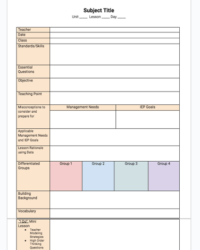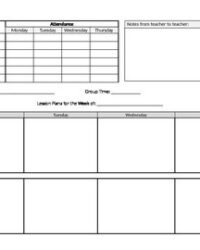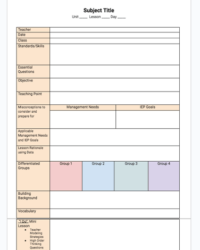As a special education resource teacher, you wear many hats, juggling diverse student needs, individualized education programs (IEPs), and a curriculum that requires significant adaptation. It’s a role that demands incredible organization, thoughtful planning, and a deep understanding of each student’s unique learning journey. The truth is, effective planning isn’t just a suggestion; it’s the cornerstone of successful instruction and student progress. Without a solid framework, even the most dedicated teacher can feel overwhelmed, losing precious time that could be spent directly with students.
That’s where a well-designed lesson plan template comes into play. Think of it as your navigational chart, guiding you through the complexities of differentiated instruction and ensuring every minute with your students is purposeful and productive. It streamlines your thought process, helps you align activities with IEP goals, and provides a clear roadmap for both you and any support staff. It’s not just about filling out a form; it’s about creating a living document that empowers you to deliver tailored, impactful lessons consistently.
The Essential Components of an Effective Special Education Lesson Plan Template
Crafting lessons for students with diverse learning needs is an art, but having a robust framework transforms it into a sustainable and efficient practice. A good special education resource teacher lesson plan template isn’t just a blank sheet; it’s a structured guide that prompts you to consider all the critical elements for successful instruction. It ensures that no crucial detail is overlooked, from individual student accommodations to assessment methods, providing a holistic view of your teaching strategy for each session.
At its core, such a template should begin with basic logistical information, such as the date, subject, and the specific IEP goals being addressed. Beyond that, it dives deeper into student-specific details, including their present levels of performance, preferred learning styles, and any necessary accommodations or modifications. This initial section acts as a quick reference, reminding you of each student’s profile at a glance, ensuring that your planning is always student-centered and aligned with their individualized plans.
Next, the template should prompt you to outline the instructional strategies and activities you’ll employ. This is where you detail your approach to differentiate content, process, and product. Will you use visual aids, hands-on activities, or multi-sensory techniques? How will you break down complex tasks into manageable steps? What guided practice will be provided, and what opportunities will students have for independent work? Thinking through these elements beforehand ensures a dynamic and engaging lesson that caters to varied learning paces and styles within your group.
Finally, a comprehensive template will include sections for assessment and progress monitoring. How will you measure student understanding during and after the lesson? What data will you collect, and how will it inform your next steps? This forward-thinking approach helps you to continuously adapt your teaching based on real-time student performance, making your instruction incredibly responsive and targeted. It’s about more than just delivering content; it’s about ensuring that every lesson contributes meaningfully to a student’s overall growth and achievement.
Tailoring Your Template to Student Needs
One of the most powerful aspects of a specialized lesson plan template is its ability to be truly individualized. You’re not just teaching a subject; you’re teaching unique learners. Your template should have clear, dedicated spaces for you to explicitly note each student’s specific IEP accommodations, such as extended time, reduced distractions, use of assistive technology, or preferential seating. This ensures these critical supports are not an afterthought but are seamlessly integrated into your daily lesson delivery, creating an equitable learning environment for every student you serve.
Integrating Common Core and State Standards
While IEP goals are paramount, it’s also vital to connect your instruction to broader academic standards. A robust special education resource teacher lesson plan template should prompt you to identify the Common Core or state standards that are being addressed within the lesson. This linkage demonstrates the relevance of your instruction, helps to bridge the gap between resource room learning and general education curriculum, and ensures that students are building foundational knowledge and skills necessary for their grade level, even as they receive individualized support.
Maximizing Efficiency with Your Special Education Resource Teacher Lesson Plan Template
Having a template is one thing; using it effectively to boost your daily efficiency is another. A well-utilized special education resource teacher lesson plan template transforms from a static document into a dynamic tool that simplifies your workload and enhances your teaching impact. It’s about moving beyond simply filling in boxes and truly leveraging the structure to pre-empt challenges, plan for diverse needs, and ensure that every instructional moment is maximized. This proactive approach saves countless hours during the week that would otherwise be spent on last-minute adjustments or trying to recall specific student needs.
One of the biggest time-savers is the template’s reusability and adaptability. While each lesson is unique to the students and their goals, many core elements or instructional strategies can be adapted and reused. By maintaining a digital library of your completed templates, you create a repository of effective lessons that can be tweaked for future groups or different IEP goals. This iterative process not only speeds up planning but also refines your pedagogical approach over time, leading to more consistent and higher-quality instruction for all your students.
Beyond personal efficiency, the template also serves as an invaluable communication tool. When shared with paraprofessionals, co-teachers, or even parents, it provides a clear, concise overview of the lesson’s objectives, activities, and expectations. This shared understanding fosters a more cohesive support system around the student, ensuring everyone is on the same page regarding instructional strategies and progress monitoring. It promotes collaboration and consistency, which are critical for students who thrive on predictability and a unified approach to their learning.
- Consistency: Ensures all necessary components are considered for every lesson, fostering a consistent approach.
- Accountability: Provides a clear record of instruction, aiding in progress monitoring and reporting.
- Reduced Stress: Streamlines planning, freeing up mental energy for teaching and student interaction.
- Enhanced Collaboration: Offers a common framework for communication with support staff and general education teachers.
- Data-Driven Decisions: Facilitates easy collection of information that informs future instructional choices.
Ultimately, a dedicated special education resource teacher lesson plan template is more than just an administrative requirement; it’s an indispensable asset. It empowers you to approach your complex role with greater clarity, confidence, and purpose. By structuring your thoughts and detailing your strategies, you create a strong foundation for every lesson, ensuring that each student receives the targeted support they need to thrive academically and personally.
Embracing and refining your use of such a template will not only streamline your daily workflow but will profoundly impact the effectiveness of your teaching. It allows you to focus less on the logistics of planning and more on the art of instruction, enabling you to truly connect with your students, respond to their needs, and celebrate their achievements, one thoughtfully planned lesson at a time.


